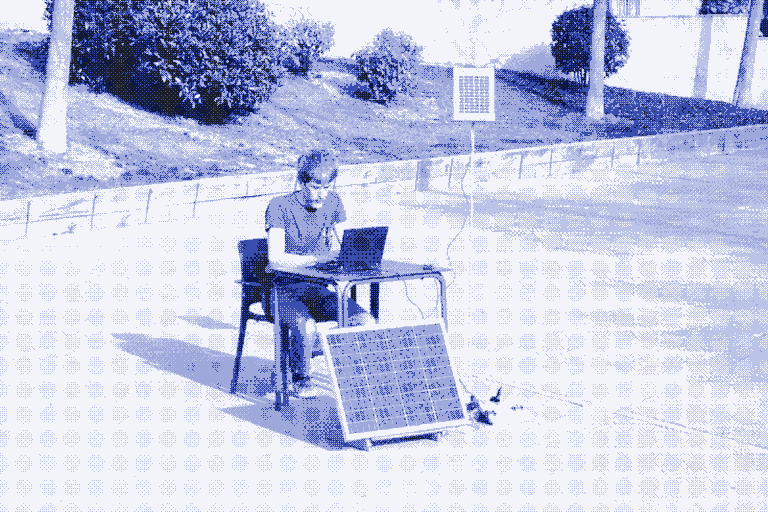Conventional solar installations do not question our dependence on fossil fuels and the energy-guzzling lifestyle that results. Both rooftop solar panels and large-scale solar farms provide us with all the power we want, even when the sun is not shining. That is because these systems use the central power grid, which largely runs on fossil fuels, as a kind of battery to cope with power shortages.
Although grid-connected solar panels can reduce the fossil fuel consumption of thermal power plants, these savings are at least partly offset by the additional fossil fuels required to build and maintain what is essentially a dual energy infrastructure. Combining solar and wind power can further increase the share of renewable energy in the power grid, but this requires further infrastructure development. Apart from energy, this also demands a lot of money and time.
Replacing fossil-fuel-fired power plants with energy storage, so that surplus electricity generated on sunny days can be stored for when there is no or insufficient sun, encounters the same problem. Energy storage, whether integrated into a power grid or located at individual households (off-grid systems), is very expensive and carbon-intensive to build and maintain.
Autonomous solar installation
The production of solar panels obviously costs money and energy. However, the financial and energy costs of the associated back-up infrastructure are many times higher. For grid-connected solar installations, these costs are very difficult to calculate precisely, but for autonomous solar installations (without grid connection and with their own energy storage) it is a lot easier. As an example, I will therefore take the small autonomous solar installation that powers my living room in Barcelona.
This system consists of two 50W solar panels on the balcony, a 100 Ah lead-acid battery and a 10A charge controller. The energy generated is used for lighting, the music system, and charging laptops and other electronic devices, among other things. The initial financial investment was 340 euros: 120 euros for the solar panels, 170 euros for the battery and 50 euros for the charge controller.
But while the solar panels should last 30 years and the charge controller about 10 years, I have to replace the lead battery on average every three to five years.1 Over a 30-year lifespan, the costs then amount to €120 for the solar panels, €150 for the charge controllers and – in the best case scenario – €1,020 for the batteries. The batteries (and associated charge controllers) therefore account for about 90% of the total lifetime costs.
Energy storage also dominates the plant’s “embedded” energy (and resulting carbon emissions). Producing my lead-acid battery took 1,200 megajoules (MJ) of energy.2 Over a 30-year lifetime (six batteries at best), that equates to 7,200 MJ. The three charge controllers add another 360 MJ over a 30-year lifetime, bringing the total energy consumption for the battery system to 7,560 MJ.3 In contrast, the production of the solar panels costs only 2,275 MJ out of a total of 9,835 MJ.4 Conclusion: more than 75% of total fossil energy consumption is due to energy storage.

Image: To the right on the balcony are the two 50W solar panels that power my flat’s living room. Next to it is the 30W solar panel that makes this website work. Photo: Marie Verdeil.
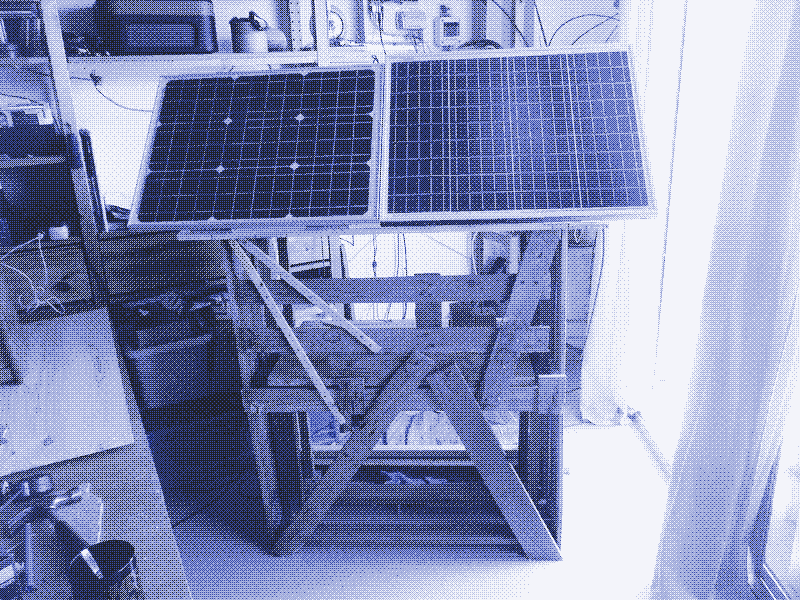
Image: The structure for the solar panels, built from waste wood. Photo: Kris De Decker.
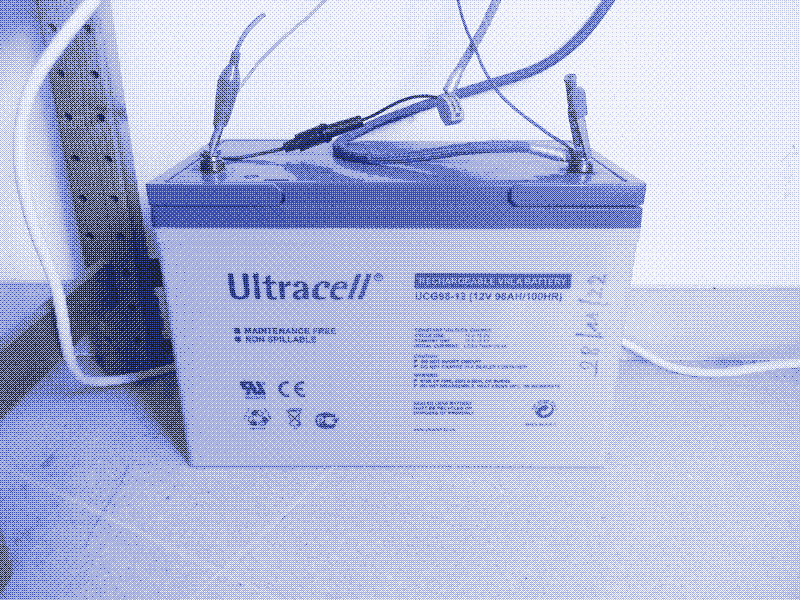
Image: The 100 Ah lead-acid battery powering the living room after sunset. Photo: Kris De Decker.
Other types of batteries would not significantly change this conclusion. For a comparable off-grid system with lithium-ion batteries, energy storage would account for about 95% of the total lifetime cost (which is almost double that of a system with lead-acid batteries). Assuming an optimistic lifetime (10 years) and including charge controllers, lithium energy storage accounts for some 70% of the energy invested in a solar grid system.5 6 For nickel-iron batteries, energy storage would account for 85% of the total lifetime cost (there are no energy cost data).7
The scale and location of the solar installation also make no difference. A larger system needs more solar panels, but also larger batteries and more expensive and powerful charge controllers. The ratios remain the same.8 The only factor that may give the solar panels a slightly larger share of the total cost is the structures on which they are mounted. I don’t take this into account because I built them myself from waste wood. However, if the solar panels are mounted on a roof, a DIY solution is less obvious. But even in that case, the cost of energy storage remains by far the biggest consideration.
Direct solar energy: much cheaper and more sustainable
Unlike fossil fuels, the sun and wind are not available on demand. The problem with our approach to renewable energy is that we insist that power should always be infinitely available, regardless of the weather, seasons or time of day. Matching energy demand to supply – as was done in the past – would lead to dramatic reductions in the cost and use of fossil fuels.
For example, if I omitted the battery storage of my solar installation, my system would become about 10 times cheaper: 120 euros instead of 1,290 euros over a 30-year lifetime. Alternatively, I could spend 1,290 euros on solar panels alone, which would give me a solar system of 1,075 watts. That’s ten times the capacity of the setup with batteries, more than what would fit on the balcony.
Without the battery and charge controller, the energy cost of the installation also drops from 9,835 MJ to 2,275 MJ. In other words, I could generate at least four times as much solar energy with the same investment in fossil fuels.
How can direct solar power be practical?
All well and good, but the sun does not shine after sunset and the amount of solar energy varies throughout the day and year. So how then can using solar panels without batteries (or other back-up infrastructure in the case of grid-connected installations) be practical?
To answer that question, we look at a pioneer of “direct solar power”: the Living Energy Farm. This environmental education community in the US state of Virginia is completely “off-the-grid” thanks to solar power, but only 10% of the solar power generated passes through a (nickel-iron) battery. However, the solar panels provide power for several homes, a communal kitchen, a metal workshop, and a farm.9 10
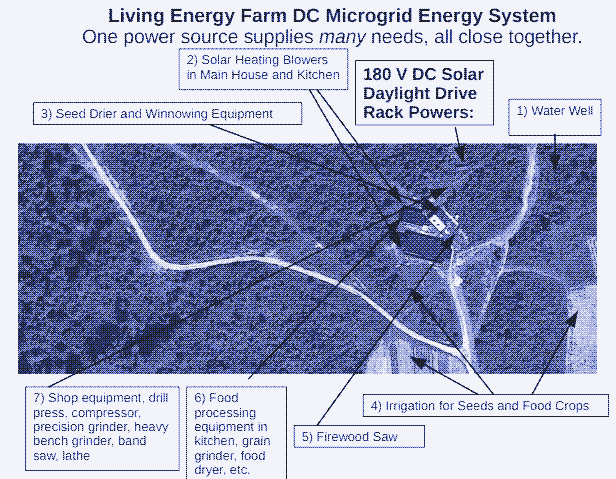
Image: direct solar power at the Living Energy Farm.
The solar installation has been in operation since 2011 and consists of separate systems with a total peak power of 1,400 watts.11 In comparison, the average peak power of a residential solar installation in the UK and the US – for one household – is 4,000 watts and 6,500 watts, respectively. As in my flat, the Living Energy Farm uses energy sparingly, but the fact that hardly any batteries are used has other reasons.
Some appliances are only used during the day
A first reason is obvious: some electrical appliances and machines are only used during the day. This is true, for example, of all machines in the metal workshop, including a band saw, compressor, grinder, circular saw, lathe, milling machine and drilling machine. It also applies to agricultural machinery such as a grain mill and a deep well pump. Linked directly to solar panels, these machines offer all the capabilities of modern grid-powered technology, with the exception that they can only be used during the day.10
On a much smaller scale, I have used direct solar power for a soldering iron, glue gun and irrigation pump (for the balcony) at home. Other examples of appliances and machines that could be used only during the day include hoovers, sewing machines, washing machines, game consoles, laser cutters and 3D printers. It is not so difficult to imagine a modern society where activities such as vacuuming and DIY chores only take place during the day. It is certainly not a return to the Middle Ages.
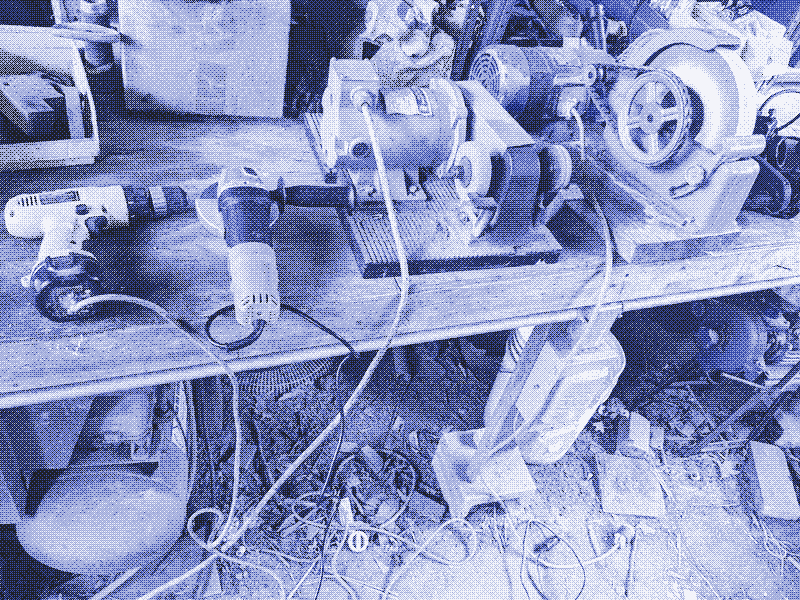
Image: several workshop tools at the Living Energy Farm, most of them run on direct solar power. Image: Alexis Zeigler.
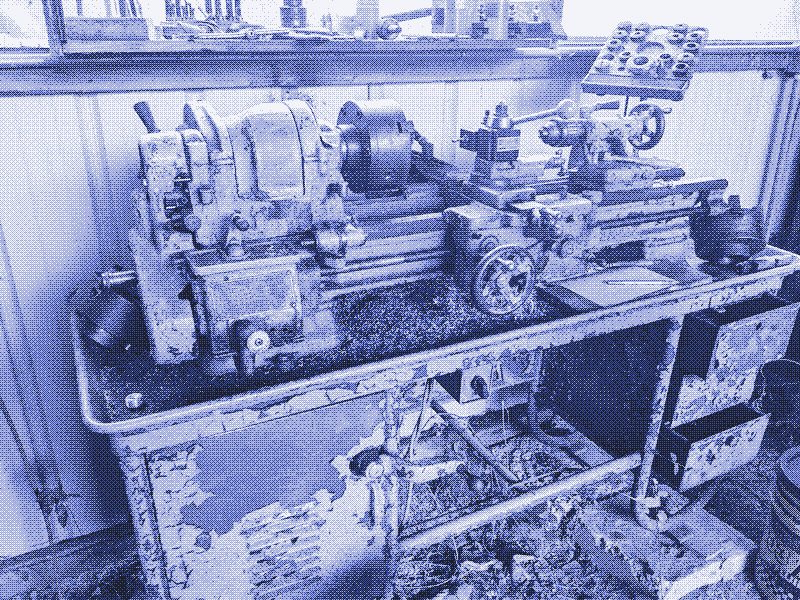
Image: Metal lathe running on direct solar power, Living Energy Farm. Image: Alexis Zeigler.
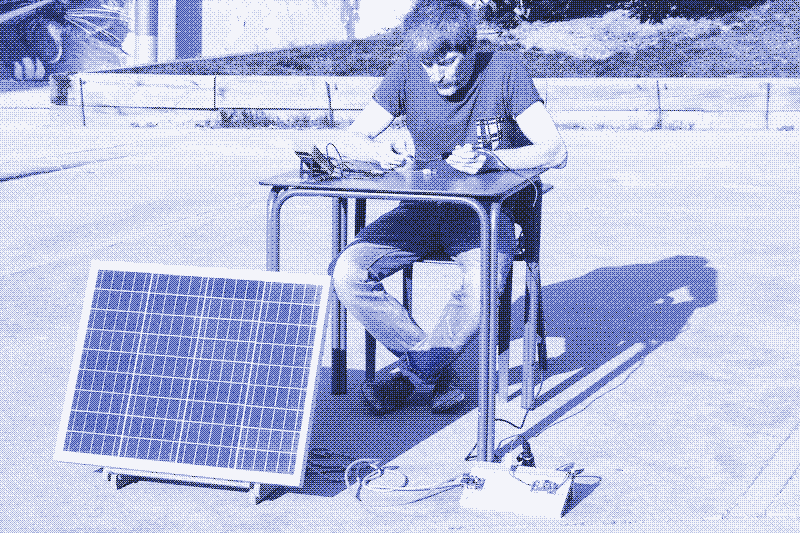
Image: Soldering with direct solar power. Photo: Marie Verdeil. Watch the video.
Moreover, not all electrical appliances require constant attention. Washing machines or dishwashers that trigger automatically when the sun shines are often cited example applications of a “smart” power grid. But that approach relies on an extensive infrastructure of electricity transmission, communication networks, and electronics-packed appliances.
In contrast, in a decentralised direct solar approach, the intelligence is provided by the sun and the rotation of the planet. A direct solar-powered washing machine or dishwasher can be fully charged and switched on in the evening. The machine then starts up “automatically” in the morning. You can even use timers (electronic or mechanical) to run different appliances one after the other.
Whether clouds pose an additional limit to a direct solar installation, and to what extent, depends on the size of the solar panels. Doubling the area of solar panels guarantees sufficient solar power during moderate cloud cover, while the installation remains much cheaper and more sustainable than a system with batteries or other backup infrastructure.
An even larger area of solar panels could provide sufficient energy even during heavy cloud cover, but increasing the size of the system tenfold brings the cost back to the level of an autonomous system with batteries. Quadrupling the area makes the system equally dependent on fossil fuels again.
Many appliances already have batteries
Direct solar power does not rule out the use of electrical appliances after sunset either. As mentioned, the Living Energy Farm has a modest battery system, providing power for lights, fans, and electronic devices after sunset, among other things.10 In addition, many modern appliances already have built-in energy storage. This is the case for all kinds of electric vehicles, for most electronic gadgets, and for older electrical appliances with AA batteries.
Consequently, these types of devices can be charged with direct solar energy during the day and then used for several hours after sunset thanks to the built-in battery. Combined with a lithium-ion power bank, a direct solar panel can also make it possible to charge USB devices after sunset. This strategy can even work for lighting, as there are many battery-powered lamps that you can use as modern torches, hung in different parts of rooms and buildings.
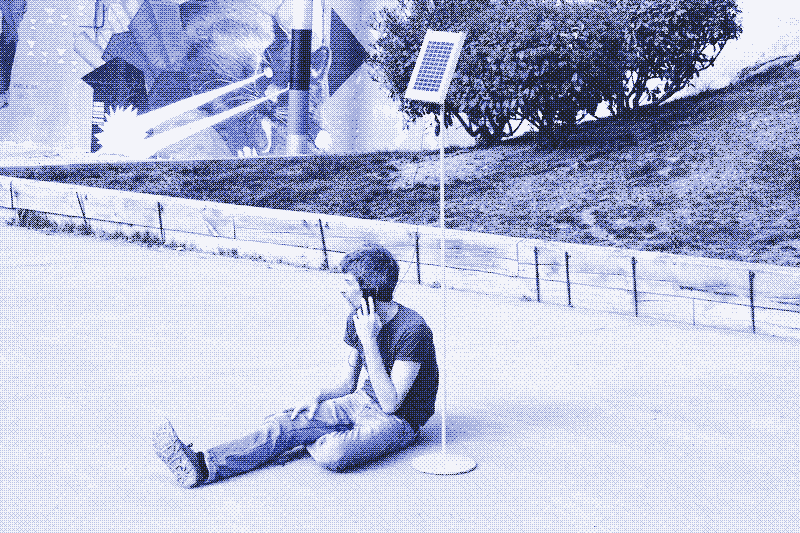
Image: A mobile phone on direct solar power. Photo: Marie Verdeil.
Of course, outsourcing chemical energy storage to the device is not the most sustainable option. The production of lithium-ion batteries requires fossil fuels, and (unlike lead-acid batteries) they are not recycled. The best solution, of course, is to reduce the use of electrical devices. But charging them with direct solar energy is a lot more sustainable and efficient than via other batteries or a fossil-fueled electricity grid. If we use high-tech devices, then preferably in the smartest way possible.
Non-electric energy storage
A third reason why direct solar power is more practical than it initially seems is that some electrical appliances can be used after sunset thanks to thermal energy storage. This is much cheaper and more sustainable than electrical energy storage. Thermal energy storage is already fairly well established for space and water heating systems, which store solar-heated water in an insulated boiler or (for space heating only) in the building envelope. It is no surprise that the Living Energy Farm has such systems, and solar thermal energy also provides hot water in my flat.
However, the same approach also works for two important household appliances that need to work after sunset and also consume a lot of electricity: the fridge and the cooker. Instead of storing electricity from a solar panel in a battery to then power a fridge or cooker after sunset, these appliances on the Living Energy Farm use thermal insulation. This keeps the heat inside (in the case of the cooker) or outside (in the case of the fridge) when there is no power supply. The thermal insulation also ensures very high energy efficiency, which means that each of these appliances can already operate on a solar panel of just 100-200 watts.
A direct solar-powered fridge
It is perfectly possible to connect a conventional fridge or freezer directly to a solar panel, but such an appliance would heat up very quickly at night. Even refrigerators with the most energy-efficient labels have a relatively limited insulation thickness (usually 2.5 cm). However, if that insulation thickness is increased to about 12.5 cm, the energy consumption of a refrigerator drops by a factor of four.12 13 The passive cooling capacity of a refrigerator can be further increased by adding thermal mass in the form of a water tank inside the appliance. During the day, the solar panel cools the water or converts it to ice. At night, this cold water or ice slows down the heating of the refrigerator.14
A direct solar-powered fridge also opens at the top, not at the front. Cold air is heavy, and so much less energy is lost that way when someone opens the door. All these design choices add up to spectacular energy efficiency. A study of direct solar refrigerators in very sunny regions (Texas and New Mexico, USA) showed that they maintained their cooling capacity for 6 or 7 days without power supply. The units operated year-round with solar panels of only 80W to 120W.15 The Living Energy Farm powers its solar refrigerator with a 200W panel.10
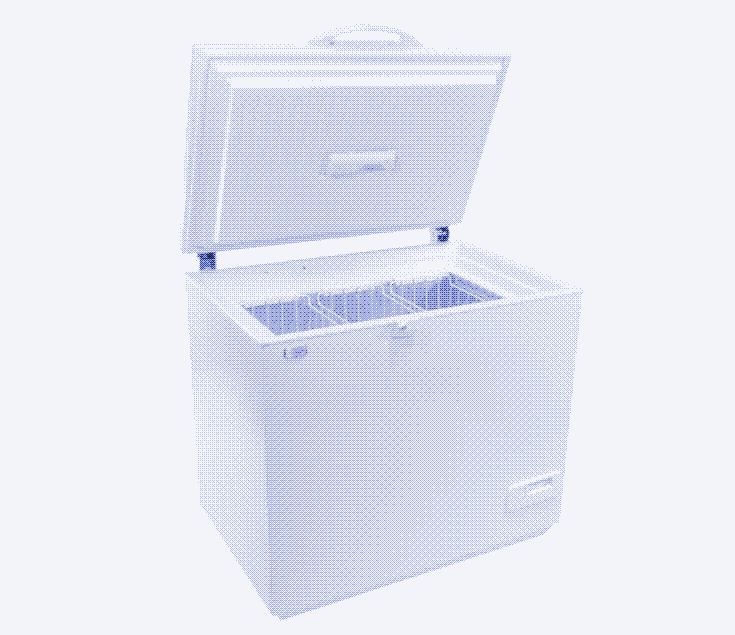
Image: The Sundanzer DDR165. A refrigerator designed specifically for direct solar power. Photo: Sundanzer.
Unlike solar heating, solar cooling is optimally tuned to seasonal variations in solar radiation. Cooling requires more energy in summer, when there is more solar energy. The aforementioned refrigerator in New Mexico recorded electricity consumption of 406 watt-hours per day in summer and only 230 watt-hours in winter.16 Moreover, the technology can be used throughout the cold chain, of which the household refrigerator is only a small (but essential) part. Another application is air cooling, although this is less well researched and more challenging.17
A direct solar electric cooker
In principle, a conventional cooker can also be connected directly to a solar panel, but as with a conventional fridge, it is not very practical. You can only cook during the day, and you have to install a lot of solar panels. A single hot plate needs 1,000 watts of electrical power. A solar electric cooker solves these problems by packing the cooktop with thermal insulation. The technology is basically a combination of an electric cooktop and a haybox.
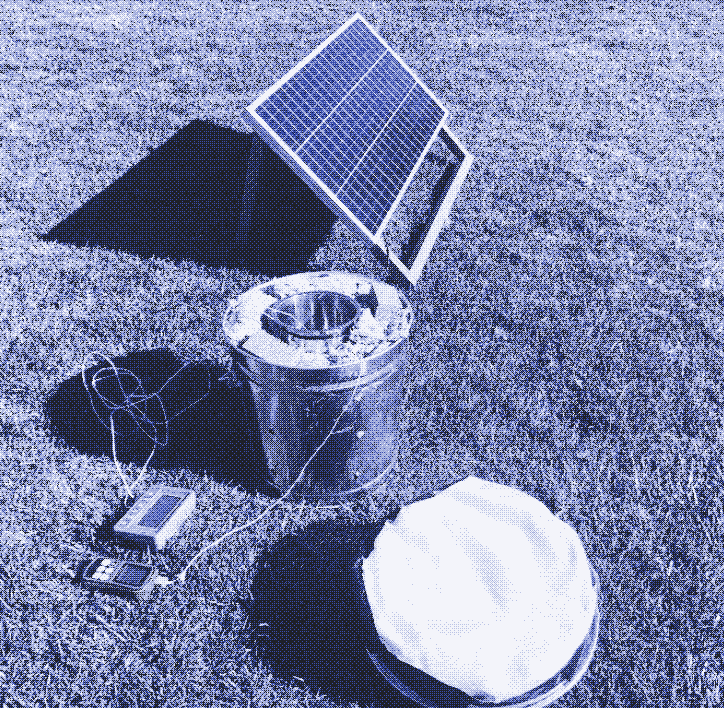
Image: Test of an electric solar cooker. Photo: California Polytechnic State University (Cal Poly).
Thanks to thermal insulation, an electric solar cooker slowly accumulates heat during the day, which can then be used for cooking after sunset. In this way, a much lower power supply can be sufficient to achieve high temperatures. Think of it as “charging” your cooker, not with electricity but with heat.
Researchers at US California Polytechnic State University (Cal Poly) built the first solar electric cooker in 2015. Their 12-volt device, which has since been further developed, needs only a 100W solar panel to work. It boils a litre of water in an hour. With a full day of sunlight, it can cook almost 5 kg of beans, rice, stew or potatoes.18
Cooking after sunset is possible by using a cooking pot with a much thicker bottom (5-10 kg). Cal Poly’s research team managed to bring the temperature of that solid heat storage to 250°C in five hours with a 100W solar panel. They were then able to boil a litre of water in three seconds after sunset. In another test, they stir-fried 1 kg of vegetables in two minutes. The ideal configuration consists of two cooking pots: one with and one without heat storage. Thus, an electric solar cooker can cook both slowly and quickly, depending on the time of day and the dish.19
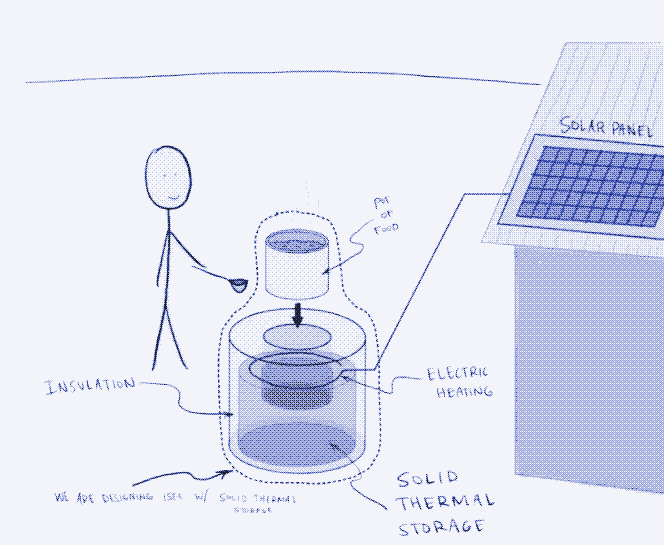
Image: The principle of a solar electric cooker with solid heat storage. Drawing: California Polytechnic State University (Cal Poly).
Thermal or electric?
Like solar water and space heating systems, cooking and cooling can work both with and without electricity – with PV panels on the one hand and solar thermal collectors on the other. But while solar space and water heating are more cost- and energy-efficient without electricity, for solar cooling and solar cooking it is just the opposite.
Space and water heating require relatively small temperature differences, which can be provided by low-cost solar thermal collectors made of glass plates and water pipes. In contrast, cooling and cooking require larger temperature differences, which require more sophisticated (vacuum tube or parabolic) solar collectors – and these are more expensive than PV panels.20 21
The only exception is a simple solar cooker – an insulated box with a glass top – but it cannot achieve such high temperatures. Moreover, an electric solar cooker has some additional advantages. With a non-electric appliance, you have to cook outside, which is less practical but also less efficient, especially in winter: a thermal solar cooker will lose more heat to the environment. An electric solar cooker is also more energy-efficient because it is insulated on all sides. It also works better in cloudy weather and can be used after sunset. At the Living Energy Farm, the parabolic solar cooker is only used in optimal conditions – at full sun and high outdoor temperatures.
What are the technical challenges?
Although the Living Energy Farm is putting all these applications of direct solar energy into practice, there are some technical challenges for those who want to follow suit. Almost all our modern technology is designed to operate with a stable and uninterrupted power supply. It doesn’t have to be that way, but for now, direct solar power usually requires some tinkering. A direct solar system is much easier to build than an autonomous system with batteries, but it often requires modifications on the appliance side.
Some devices can be connected directly to a solar panel: it is enough to connect the positive and negative contacts of the solar panel and the device. For example, machines with a DC motor tolerate large fluctuations in the power supply. The metal workshop and agricultural machinery at the Living Energy Farm work this way. If clouds block the sun, the combined electrical load can become greater than the power supply from the solar panels, but this does not stop the machines. All the engines will slow down because they share the available energy, but they all continue to do useful work.10 22
The same applies to all appliances that work on the basis of resistive heating elements, such as kettles, hotplates or electric heating systems. They work regardless of power or voltage, just slower or faster. A direct solar-powered fridge preferably operates on a variable DC compressor, which can adjust its speed according to the varying solar power production.10 23
Many other devices need a specific and stable voltage input, which usually does not match what the solar panel produces. This can be solved by placing a DC-DC converter (a “buck” or “boost” converter) between the solar panel and the device. This is a small electronic module that converts the fluctuating voltage of a solar panel into a constant output voltage for a low-voltage device (5V, 12V or higher).24
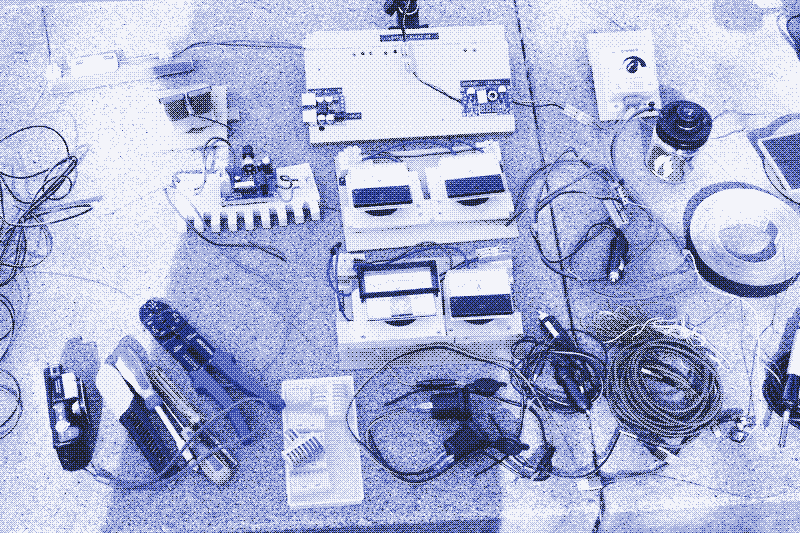
Image: Experiments with direct solar power. Photo: Marie Verdeil.
If you use an inverter in addition to this, even mains appliances can operate directly on a solar panel.25 DC-DC converters are essential for all appliances that contain electronic components. This is the case for many appliances today, including those, such as washing machines or coffee machines, that until recently operated without electronics. That often gives you two options to run such appliances on direct solar power. You can either fit a DC-DC converter or modify the appliance by bypassing the electronics.
DIY manuals & commercial devices
Most direct solar power applications operate at low voltage, so you can safely do it yourself. Low-tech Magazine will soon publish a manual on this. However, the Living Energy Farm uses direct current with higher voltages for a number of applications. Examples are the machine tools in the metal workshop (90V) and a number of powerful electric solar cookers (48V, 180V). It is not a good idea to build these systems yourself unless you have the help of a qualified electrician, as these voltages can lead to fatal accidents.
Those wishing to build their own (low-voltage) electric solar cookers will find comprehensive manuals at both Living Energy Farm and Cal Poly.26 The devices can be made with simple materials. The insulation material should be fireproof. Example materials are rock wool, fibreglass, natural wool or clay.goed.
Different technologies can be used for heating elements, but embedding nichrome wires in cement is the simplest option. These wires can be taken from a variety of appliances such as toasters, ovens and hotplates. In principle, the heating wires can be attached directly to the cooking pot, but it is more practical to make a heated “nest” in which a pot can be placed.
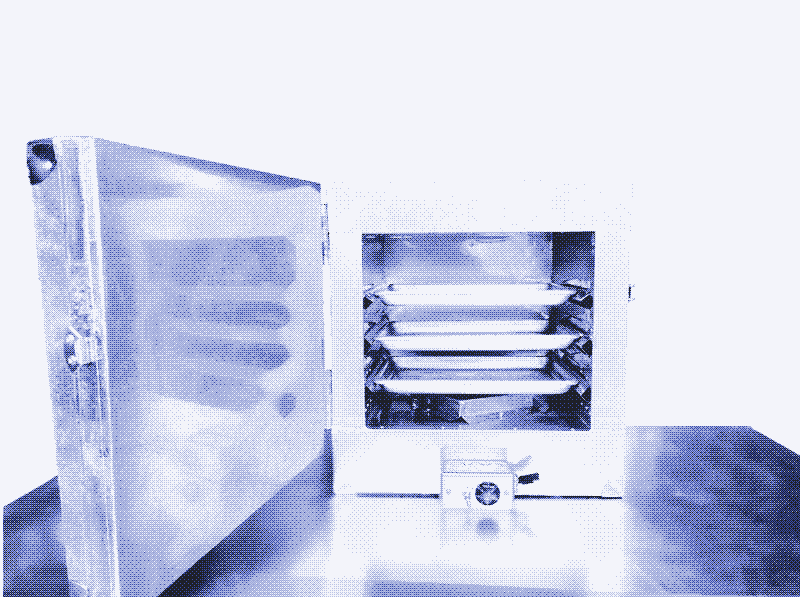
Image: Inspired by Cal Poly’s work, Living Energy Farm also developed a number of electric solar cookers, one of which they offer for sale through their website. The Roxy Oven can be used as a hotplate or an oven, for example for baking bread. The door also remains closed when used as a hot plate. This solar cooker has no energy storage.
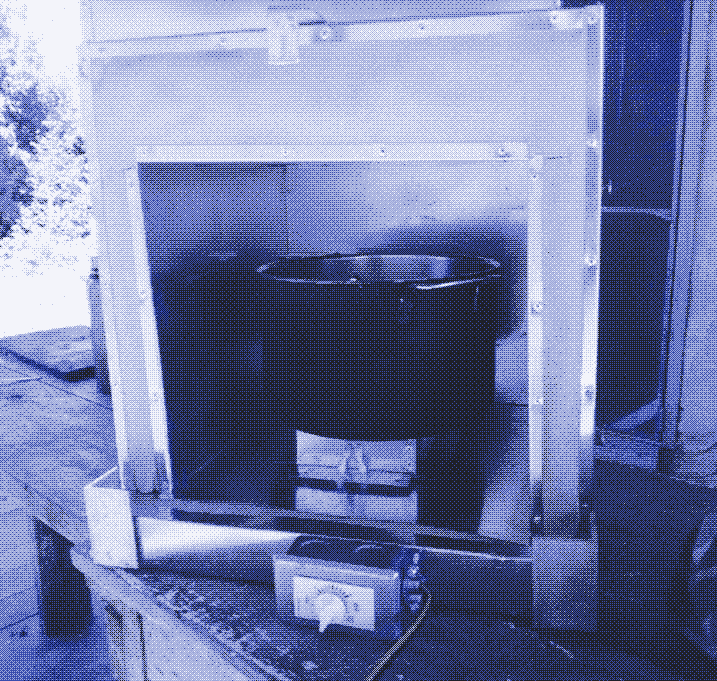
Image: The Roxy Oven without the door and with the glass wool insulation visible. The device – made in the metal workshop with direct solar power – runs on 48V and requires a solar panel of 200 to 500 watts. Living Energy Farm also offers Sunstar’s solar refrigerator for sale online.
Does direct solar power waste energy?
The sustainability of a solar installation depends not only on the energy required to produce and maintain the infrastructure, but also on the energy produced by the solar panels during their lifetime. Some people will argue that direct use of solar power is inferior to conventional grid-connected or battery-powered solar installations in this respect.
After all, the hoover, washing machine and power drill are not used every day, and if no electrical appliance is connected then a solar panel will not produce power either. Consequently, the amount of electricity produced by the panel will decrease over its lifetime, while the energy needed to manufacture the panel remains the same. This makes the power from a direct solar panel more carbon-intensive.
However, because energy storage in batteries (or the grid-connected alternative) accounts for such a large proportion of the total energy invested, a standalone solar panel can waste quite a lot of energy before it becomes less sustainable than its counterpart with battery storage or grid connection.
Moreover, direct use of solar power avoids the charging and discharging losses caused by batteries, or the energy losses in the transmission infrastructure for grid-connected systems. Both have to be offset by additional solar panels. Furthermore, solar panels connected to batteries or the grid also waste power – a consequence of the large difference in energy production between summer and winter.
Maximising direct solar power with collective services
Nevertheless, it is important to maximise the energy production of a direct solar panel. In that context, it is useful to return for a moment to the original example system located on my balcony. Direct solar power could be a nice addition to this system, especially for the fridge and cooker. It was because of these appliances that I concluded in 2016 that it was impossible to completely disconnect my flat from the grid.
However, the Living Energy Farm shows that it could be done: there is room for a further 200 watts of solar panels (4 x 50W) on the balcony, enough to power both a thermally insulated fridge and hob. Additional battery capacity would not be needed.
For other appliances, however, direct solar power is of little use in my case. It would not be very efficient to install an extra solar panel for the washing machine or the power drill, as they are only used occasionally. This seems to play into the hands of a “smart” electricity grid, because that way many households can use the same solar power – there is always someone who needs to wash clothes or drill a hole.
However, such a smart grid does require a lot of infrastructure, even if direct solar power were to be used at that scale. It may not require batteries or fossil fuels as backup, but it does require transmission and communication infrastructure.
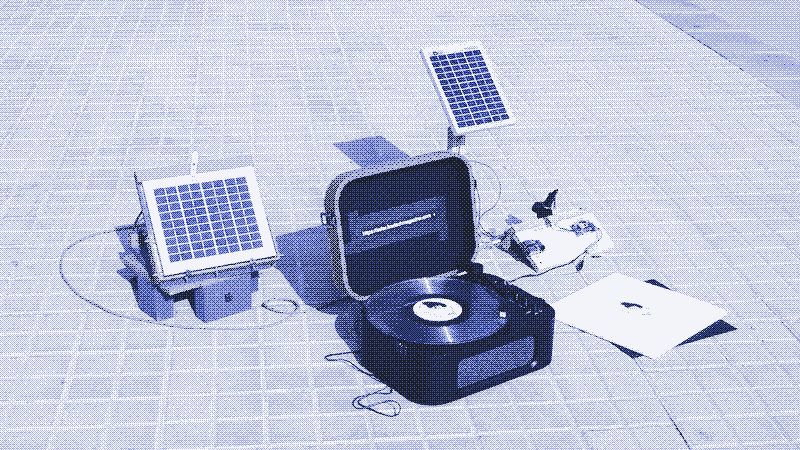
Image: A record player on direct solar power. Photo: Marie Verdeil. Watch the video.
The Living Energy Farm demonstrates an alternative solution: the communal organisation of household tasks and work. Instead of a communal power grid distributing energy to many indidvidual households, we can set up collective services with decentralised energy production.
In the Living Energy Farm communal workshop, direct solar power can be used much more efficiently than in an individual workshop that is only used occasionally. A collective laundry in each street would also use direct solar power much more efficiently. Moreover, we save a lot of energy on building appliances this way, and gain a lot of space.
Direct wind power?
This strategy becomes even more important if we choose not direct solar power but direct wind power – or a combination of both. The Living Energy Farm is located in a sunny region, but the same approach could also work in windy places.
However, there is an important difference between solar power and wind power. The efficiency of a solar panel does not depend on its size, which makes solar power ideal for decentralised energy production. In contrast, the efficiency of a wind turbine increases more than proportionally as the rotor diameter increases. Much better than one wind turbine per household, therefore, is a somewhat larger wind turbine for a community of households, e.g. for powering a collective laundry or workshop.
- The service life of lead-acid batteries depends on many factors. If they are discharged too deeply or are not fully charged regularly, the service life can be shorter than three years. On the other hand, a lead-acid battery that is hardly used or not discharged at all can last much longer than five years. However, the academic literature states a life expectancy of three to five years and this has also been my experience with the batteries I have used since 2016. See, for example, “Optimal Sizing and Life Cycle Assessment of Residential Photovoltaic Energy Systems With Battery Storage”, A. Celik, in “Progress in Photovoltaics: Research and Applications”, 2008. & “Energy pay-back time of photovoltaic energy systems: present status and prospects”, E.A. Alsema, in “Proceedings of the 2nd World Conference and Exhibition on photovoltaics solar energy conversion”, July 1998. ↩︎
- Manufacturing a lead-acid battery (based on largely recycled materials) takes about 1 MJ of energy per watt-hour of storage capacity. My 100 amp-hour battery equates to a storage capacity of 1,200 watt-hours, and so the embedded energy equals 1,200 MJ. Over a 30-year lifespan, I need six of these batteries at best, so 7,200 MJ in total. Source: “Energy Analysis of Batteries in Photovoltaic systems. Part one (Performance and energy requirements)” and “Part two (Energy Return Factors and Overall Battery Efficiencies)” (PDF). Energy Conversion and Management 46, 2005. ↩︎
- Not much research has been done on the embedded energy of charge controllers. The most relevant data I found is a value of 1 MJ per watt maximum power: Kim, Bunthern, et al. “Life cycle assessment for a solar energy system based on reuse components for developing countries.” Journal of cleaner production 208 (2019): 1459-1468. For a capacity of 120W (my charge controller has a maximum capacity of 10A x 12V = 120W), this amounts to 120 MJ. For the estimated lifetime, I found values of 7 and 12.5 years: same reference as above, as well as: Kim, Bunthern, et al. “Second life of power supply unit as charge controller in PV system and environmental benefit assessment.” IECON 2016-42nd Annual Conference of the IEEE Industrial Electronics Society. IEEE, 2016. I therefore made the calculation on an estimated lifetime of 10 years. ↩︎
- Nawaz, I., and G. N. Tiwari. “Embodied energy analysis of photovoltaic (PV) system based on macro-and micro-level.” Energy Policy 34.17 (2006): 3144-3152. According to this widely quoted source, it takes 3,500 MJ to produce 1 m2 of solar panel. My two solar panels together measure 0.65 m2, representing a total energy cost of 2,275 MJ. A more recent literature review puts the energy cost for producing different types of solar panels at between 1,034 and 5,150 MJ/m2. The most recent studies of silicon solar panels in this review put the energy cost at around 1,000 MJ/m2, much lower than the figure I am using. See: Ludin, Norasikin Ahmad, et al. “Prospects of life cycle assessment of renewable energy from solar photovoltaic technologies: A review.” Renewable and Sustainable Energy Reviews 96 (2018): 11-28. ↩︎
- Lithium-ion batteries are a lot more expensive than lead-acid batteries, but unlike lead-acid batteries, they can be discharged deeper (up to 15% of their total capacity) and have a longer lifespan (7 to 10 years). Consequently, fewer and smaller batteries are needed. Taking these factors into account, the lifetime cost of the battery is €750, compared with €1,020 for lead-acid batteries. On the other hand, lithium-ion batteries require a more sophisticated and more expensive charge controller: a 10A charge controller costs between 200 and 600 euros, depending on the quality. Assuming a price of 400 euros for the charge controller and a 10-year lifetime for both the battery and the charge controller, battery storage accounts for 95% of the total lifetime cost (a total of 2,070 euros, much more than the total cost for the system with lead-acid batteries). Sources: https://www.lithiumion-batteries.com/products/product/12v-50ah-lithium-ion-battery & https://www.lithiumion-batteries.com/products/12v-lithium-ion-battery-chargers/ ↩︎
- Although the production of a lithium-ion battery costs more energy than the production of a lead-acid battery (1.4-1.9 MJ/Wh versus 1 MJ/Wh), this is offset by a longer lifespan and greater discharge capacity. The energy cost of lithium-ion batteries over a 30-year lifetime is then about 3,000 MJ, significantly less than a comparable lead-acid battery system. In contrast, the charge controller contains more complex electronics. Unfortunately, no data is available for the energy cost of such a charge controller. So there is no alternative but to estimate the energy cost based on the financial cost, which is four to twelve times more expensive than a charge controller for a lead-acid battery. Assuming a four times higher cost, the embedded energy of the charge controller increases to 480 MJ, or 1,440 MJ over a 30-year period. The total energy cost for the system is then 6,685 MJ, less than a comparable system with lead-acid batteries. Of this, almost 70% is attributable to battery storage. ↩︎
- Nickel-iron batteries are even bigger and heavier than lead-acid batteries and they need regular maintenance. But they can be fully discharged and have a very long service life (20 years). Moreover, they can be used with the same charge controllers as lead-acid batteries. The lifetime cost over 30 years for the battery is €750, cheaper than the six lead-acid batteries of similar capacity. The total lifetime cost for a nickel-iron battery system with 100W solar panels is €1,020, of which 85% goes to energy storage. Unfortunately, nickel-iron batteries are hard to find, especially the smaller models. Sources: https://beyondoilsolar.com/product/nickel-iron-battery-industrial-series/ & https://beyondoilsolar.com/product-category/batteries/nickel-iron/ ↩︎
- Actually, the price of solar panels in a somewhat larger solar installation would be proportionally even smaller. This is because solar panels with small sizes (such as 50W) are proportionally more expensive per watt of peak capacity than solar panels with more conventional sizes (from 250W onwards). More or less the same applies to the energy cost. ↩︎
- https://livingenergyfarm.org ↩︎
- Alexis Zeigler, founder of the Living Energy Farm, wrote a book about the project, which is available in full online: Empowering Communities. A Practical Guide to Energy Self Sufficiency and Stopping Climate Change. It can also be ordered in hard copy. ↩︎ ↩︎ ↩︎ ↩︎ ↩︎ ↩︎ ↩︎
- Since direct solar power does not require a charge controller for each separate system, splitting up a solar system does not involve any additional costs or energy consumption. ↩︎
- Research shows that doubling the insulation thickness from 2.5 cm (standard insulation) to 5 cm reduces the annual electricity consumption of a refrigerator (50 litre capacity) from 250 to 125 kilowatt hours.13 With an insulation thickness of 10 to 12.5 cm, electricity consumption halves again to around 60 kilowatt hours per year. Even thicker insulation brings a smaller reduction in electricity consumption and is no longer attractive because thicker insulation also increases the cost and size of the refrigerator. The study concerns a solar-powered AC fridge that operates thanks to an inverter and a battery, which is less energy-efficient than a direct solar-powered fridge. ↩︎
- Gupta, B. L., Mayank Bhatnagar, and Jyotirmay Mathur. “Optimum sizing of PV panel, battery capacity and insulation thickness for a photovoltaic operated domestic refrigerator.” Sustainable Energy Technologies and Assessments 7 (2014): 55-67. ↩︎ ↩︎
- This thermal mass can literally be a container of water placed inside the fridge. or some water bottles for drinking. But the water can also be stored in reservoirs along the side of the appliance, behind an inner lining that keeps them in place and hides them from view. Water has a higher heat storage density than air, keeping the temperature stable for longer. ↩︎
- Ewert, M., et al. “Photovoltaic direct drive, battery-free solar refrigerator field test results.” Proceedings of the solar conference. American solar energy society; American institute of architects, 2002. ↩︎ ↩︎
- This advantage only applies if the fridge is set up in an unheated room. The modern habit of placing a fridge in a heated kitchen when the outside temperature in winter is equal or lower than that in the fridge is obviously absurdly wasteful. But neither is this advantage valid in tropical countries, where temperatures are high all year round. ↩︎
- The use of direct solar power for space cooling has not been analysed as thoroughly as for domestic refrigerators. See: Luerssen, Christoph, et al. “Life cycle cost analysis (LCCA) of PV-powered cooling systems with thermal energy and battery storage for off-grid applications.” Applied energy 273 (2020): 115145. Moreover, it is unlikely to achieve equally large energy savings. A refrigerator is always insulated, but in the case of an air-cooled room or building, this is not necessarily the case. Moreover, a refrigerator is set up in a room where there is a stable temperature. A building is subject to greater temperature fluctuations and can also be heated by direct solar radiation. So direct solar air cooling is a lot more complicated. See: Qi, Ronghui, Lin Lu, and Yu Huang. “Parameter analysis and optimisation of the energy and economic performance of solar-assisted liquid desiccant cooling system under different climate conditions.” Energy conversion and management 106 (2015): 1387-1395. ↩︎
- Solar Electric Cooking, Pete Schwartz, Cal Poly Physics. See also this PowerPoint by the same author. ↩︎
- Insulated Solar Electric Cooker with Solid Thermal Storage, Andrew McCombs et al., 2022. See also this video. ↩︎
- See: Ferreira, Carlos Infante, and Dong-Seon Kim. “Techno-economic review of solar cooling technologies based on location-specific data.” International Journal of Refrigeration 39 (2014): 23-37. ///// Riffat, James, et al. “Development and testing of a PCM enhanced domestic refrigerator with use of miniature DC compressor for weak/off grid locations.” International Journal of Green Energy 19.10 (2022): 1118-1131. ///// Du, Wenping, et al. “Dynamic energy efficiency characteristics analysis of a distributed solar photovoltaic direct-drive solar cold storage.” Building and Environment 206 (2021): 108324. ///// Alsagri, Ali Sulaiman. “Photovoltaic and photovoltaic thermal technologies for refrigeration purposes: an overview.” Arabian journal for science and engineering 47.7 (2022): 7911-7944. ↩︎
- For lack of research, whether the same applies to embedded energy consumption is not clear. ↩︎
- In both cases, however, it is necessary to bypass the device’s switch, because DC electricity produces more heat than AC electricity. Instead, a suitable external switch can help, but in doing so you bypass the device’s safety mechanism, which is obviously a risk. 10 Again, this does not have to be the case: it is technically possible to make devices suitable for direct solar power. ↩︎
- A fixed-speed compressor can only use 50% of the solar power produced in a useful way, while a variable-speed compressor uses about 75% in a useful way. 15 A capacitor is needed to provide the compressor with an energy boost during the start-up phase. ↩︎
- Instead of a DC-DC converter, you can also install a small “buffer battery” and a charge controller. Like a DC-DC converter, the charge controller will ensure a stable output voltage. In addition, the small battery can provide limited energy storage that can be useful to handle short spikes in power consumption. For example, some devices have a current spike when charging. The disadvantage of a buffer battery is that the cost and embedded energy increase, and additional components can fail. A capacitor is an alternative technology to absorb power peaks. ↩︎
- However, using low-voltage direct current devices is a lot more energy-efficient because solar panels also produce low-voltage direct current: https://solar.lowtechmagazine.com/2016/04/slow-electricity-the-return-of-dc-power/ ↩︎
- Insulated Solar Cooker Construction Manual, Living Energy Farm. Insulated solar electric cooker manual, Pete Schwartz, Cal Poly Physics. Roxy Oven Manual, Living Energy Farm. Video presentation manual solar electric cookers, Alexis Zeigler, Living Energy Farm. Video manual for making heating wires. Thermal heat storage: Insulated Solar Electric Cooker with Solid Thermal Storage, Andrew McCombs et al., 2022. Also see this video. ↩︎


